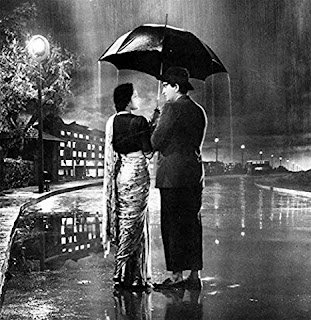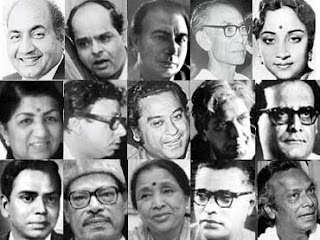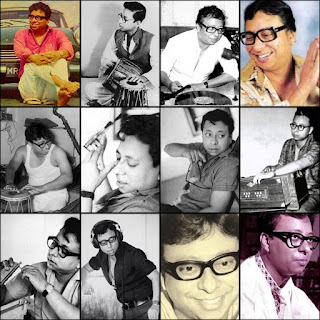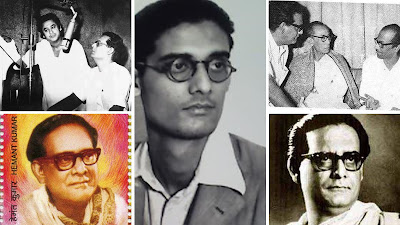PART 4 OF 10: THE THIRSTY GURU AND THE FIESTY KING (NO, THAT IS NOT A CHINESE MOVIE TITLE...)
Raj Kapoor was a genius at enhancing the movie experience for his audiences. He regaled them with songs and sentiments, elaborate sets and costumes, and tramped about in his favorite Chaplinesque avatar. His scorching chemistry with the stylish Nargis only added to the effect, further accentuated by the incredible camera work of Radhu Karmakar. Raj was the Ultimate Showman. For the world outside of India, he embodied Indian cinema like no one else has ever since - not even Satyajit Ray. Time magazine in its 'All Time Best Movies...' tribute called him, "India in all its vitality, humanity and poignancy". That was Raj Kapoor.
There was another gentleman who was going to take that art of visually enrapturing the audience to a completely new level. The person’s name was Vasanth Kumar Shivashankar Padukone – popularly known as Guru Dutt. Guru Dutt was born to a Konkani family in current-day Karnataka but spent much of his early life in Kolkata. He debuted as a director with the Dev Anand-starrer and the sleeper hit, 'Baazi' in 1951. He turned an actor by accident in the 1953 film, 'Baaz'. The film flopped, but he followed it up with successive hits in 'Aar Paar', 'Mr & Mrs. 55', and 'C.I.D'. But his best was yet to come.
Dutt who was known for his crime thrillers and light-hearted films till then, turned darker and artsy with 'Pyaasa'. The movie was released in early 1957. The year the Russians launched the Sputnik, triggering a race to the moon and into space. 'Pyaasa' became a runaway hit and is considered to be Guru Dutt's finest work. When Time magazine published its list of '100 Movies of all time' in 2005, 'Pyaasa' was one of just three Indian movies that made it - the other two were Ray's 'Apu Trilogy' and Mani Ratnam's 'Nayakan'. With 'Pyaasa', Guru Dutt entered the seriously elite group of Bombay filmmakers who mixed art and commerce in right proportions and made epic films - Bimal Roy, Mehboob Khan, and Raj Kapoor. Guru Dutt was all of thirty-two when 'Pyaasa' came out. He would be dead in seven years. Not before he had experienced it all. He rose to his peak with 'Pyaasa', ran himself to penury with the self-prophesizing 'Kaagaz ke phool', bounced back to deliver hits through 'Sahib Biwi Aur Ghulam' and 'Chaudivin Ka Chand', fought and separated from his wife Geeta Dutt, romanced Waheeda Rahman, and allegedly took his own life in 1964. He was only thirty nine. Sadly, almost his entire family was doomed to self-destruction: Geeta Dutt and son, Arun Dutt died early due to alcoholism. Another son, Tarun Dutt, took his own life like his father.
Pyaasa, by no
means, was the biggest commercial success of 1957. That honor went to another Hindi classic, 'Mother India'. In fact, 1957 was another auspicious year for movie
classics in Bombay: 'Mother India', 'Naya Daur', 'Do Ankhen Barah Haath', 'Tumsa Nahin
Dekha', and 'Paying Guest' were all released to great reception that year.
Okay, that was Guru Dutt. Let's talk SD Burman for a bit. Sachin Dev Burman was from the royal family of Tripura and was born to the heir of the Kingdom of Tripura, sitarist and Dhrupad singer, (take a deep breath) Mahamanyabar Rajkumar Nabadwipchandra Dev Burman, and the Princess of Manipur, Nirmala Devi. His father and he were sidelined, through Rajatantram, by his paternal uncle. The good news for us is, instead of slugging it out for the throne and indulging in heroisms like Bahubali, SDda just focused on his music. You see, our guy wasn't interested in ruling kingdoms as much as he was into ruling the hearts of music lovers (ayyo, ayyo...really corny, I know).
Right from the time that he made his debut in Bengali with 'Rajgee' (1937), leading up to his maiden Hindi picture 'Shikari' (1946), to his first big hits in 'Do Bhai' and 'Baazi', SD Burman brought in a new sensibility to film music than what was prevalent then. His USP was to create a meeting ground between a North-eastern folksy refrain that ran in his veins, a Hindustani classical fervor that he brought from years of rigorous training with stalwarts like Vishmadev Chattopadhyay and Ustad Allaudin Khan, and a western ballad style that he picked up along the way. All of this made it seem like he was Salil Chowdhury, Naushad, and Shankar-Jaikishan, all rolled into one. That was SDda for you. The complete musician.
Referring to his penchant for making memorable music with deceptively "easy" loops, Music Maestro Ilaiyaraja said this about SDB's masterpiece 'Khilte hain gul yahaan', set in Raag Bhimplaasi, in the movie 'Sharmilee': "Each phrase in the song seems to be the same as the one before, but makes you want to listen to it again and again, for it has more meaning than the previous time!"
While we are on it, I can't help but relate another anecdote involving Ilaiyaraja (I am a fan, you see). Actor Kamal Haasan apparently went to Ilaiyaraja with a request for a tune that would be repetitive and borderline monotonous for his movie 'Devar Magan'. Knowing that Ilaiyaraja was an ardent SDda fan, he cited 'Yeh dil deewana hai, dil to deewana hai, deewana dil hai yeh, dil deewana' (what a song!), as an example. Ilaiyaraja apparently (re)created the masterpiece 'Inji idupazhagi' inspired by SDda's tune.
The other specialty about SDda was how he evolved with times. He composed for over a hundred films spanning four decades and had super hits in every period till his very last film, 'Mili', in 1975. The vivacity of SDda of the 40s and early 50s ('Baazi', 'Pyaasa', 'Chalti ka naam gaadi') to the richness of his music in the 60s ('Guide', 'Jewel Thief', 'Aradhana') to his depth in the 70s ('Sharmilee', 'Abhimaan', and 'Mili'). You can have your pick!
I had trouble choosing one song from the brilliant album that is 'Pyaasa'. There is an OP Nayyarish quality to the Mohd Rafi-sung 'Sar jo tera chakraaye' filmed on Johnny Walker; the haunting 'Jaane woh kaise', which only Hemant Kumar could have done justice to; the chirpy 'Jaane kya tune kahi' by Geeta Dutt; or the almost-biblical ballad 'Yeh duniya agar mil bhi jaaye' (all of the songs with beautiful camera work by Guru Dutt's "eyes": VK Murthy). I picked the topical 'Jinhe naaz hai Hind par', sung by Mohammad Rafi and picturized on a drunk Guru Dutt roaming about the dark alleys of the red-light district of Calcutta. Dutt's character sings in agony over the deplorable state of women and calls the powers-that-be to do something about it. Rafi is at his absolute best. But this number, for me, edged out the others for one reason: the stunning lyrics penned by Sahir Ludhianvi.
Ludhianvi was the court poet of SD Burman (sadly 'Pyaasa' was their last collaboration). Earlier in his life, his association with the Progressive Writers' Association and his communist leanings got him into trouble with the Pakistani establishment. He fled to India from his native Lahore and eventually settled down in Bombay. This was the time of the 'Second Red Scare' when the infamous US Senator McCarthy, was hounding out Communists in the US, especially in Hollywood. The Indian government, similarly, was actively chasing film personalities with a communist leaning - the likes of Majrooh Sultanpuri, Balraj Sahni, and others - and imprisoned them for their alleged plot to overthrow the central government. Ludhianvi lay low and remained apolitical, at least overtly, but wrote some hard-hitting lyrics and nazms to satiate his intellectual hunger. If he had written lyrics like this today - 'Jinhe naaz hai Hind par woh kahaan hai'- he was certain to have been declared an urban naxal, abused on Twitter, and asked to "Go back to Pakistan". At least, this one time, the custodians of our culture would have gotten the country of his origin right.
Here is my attempt at lost-in-translating Ludhianvi's lyrics.
yeh luT-te huwe karvaa.n zindagee ke,
kahan hain, kahan hain muhaafiz Khudee ke,
jinhen naaz hai Hind par woh kahaan hain,
kahaan hain, kahaan hain, kahaan hain?
These by-lanes, these houses that auction off the human flesh,
These pillaged and crumbled caravans of the long-lived,
Where are they? Where are they, the prudish that protect us?
Those proud of Hind, where are they, the righteous?
Where are they, where are they, where are they?
yeh pur-paich galiyaan yeh badnaam baazaar,
yeh gumnaam raahee, yeh sikkon kee jhankaar,
yeh ismat ke sauday yeh saudon pe takraar,
jinhen naaz hai Hind par woh, kahaan hain,
kahaan hain, kahaan hain, kahaan hain?
These treacherous streets, and the bazaar so sinful,
This nameless traveler, and the coins that jangle,
These unchaste deals, and the hard-hitting bargains,
Those proud of Hind, where are they, the saints?
Where are they, where are they, where are they?
yeh sadiyon se be-khauf, sehmee see galiyaan,
yeh maslee huwee adh-khilee zard kaliyaan,
yeh biktee huwee khoklee, rang-raliyaan,
jinhen naaz hai Hind par woh kahaan hain,
kahaan hain, kahaan hain, kahaan hain?
These dingy lanes, that are for ages fearless,
These feeble flowers, half-budded and colorless,
These shallow past times, in the market for sale,
Those proud of Hind, the leaders that we hail,
Where are they, where are they, where are they?
Woh ujle darichon mein paayal kee chann chann,
thakee haaree sansoon mein table ki dhan dhan,
yeh be-rooh kamron mein khaansee kee Thann Thann,
jinhen naaz hai Hind par woh kahaan hain,
kahaan hain, kahaan hain, kahaan hain?
Those lighted windows, adorned with anklets tinkling,
The tired and the lost gasps, over tablas resounding,
These soulless rooms with sickly coughs echoing,
Those proud of Hind, are they all sleeping?
Where are they, where are they, where are they?
Yeh phoolon ke gajre, yeh peekon ke chheentay,
yeh be-baak nazren yeh gustaaKh fiqaren,
yeh Dhalke, badan aur yeh beemar chehre,
jinhen naaz hai Hind par woh kahaan hain,
kahaan hain, kahaan hain, kahaan hain,
These garlands of flowers and the stains of spit,
These smug stares and the ribald wit,
These sulking bodies and the off-color faces,
Those proud of Hind, rouse them from their high places,
Where are they, where are they, where are they?
Yahaan peer bhee aa chuke hain, jawaan bhee,
tano-mand beTe bhee, abba miyaan bhee,
yeh beewee bhee hain aur behen bhee, hain maa bhee,
jinhen naaz hai Hind par woh kahaan hain,
kahaan hain, kahaan hain, kahaan hain?
The elders have been here, as have the younger,
the lustful son, the father and the teacher,
To be with wives and sisters, and their mothers.
Those proud of Hind, the fathers and the brothers,
Where are they, where are they, where are they?
Madad chaahtee hai yeh hawwa kee beTi,
Yashoda kee hamm-jins Radha kee beTi,
Payambar kee ummat, Zulekha kee beTi,
jinhen naaz hai Hind par woh kahaan hain,
kahaan hain, kahaan hain, kahaan hain?
The daughter of Eve is crying for help,
The twin of Yashoda and the daughter of Radha,
The Prophet's followers, and the daughter of Zulekha
Those proud of Hind, where are they right now?
Where are they, where are they, where are they?
Zaraa mulk ke, rah-baron ko bulaao,
yeh kooche yeh galiyaan yeh manzar dikhaao
jinhen naaz hai Hind par, un-ko laao,
jinhen naaz hai Hind par woh kahaan hain,
kahaan hain, kahaan hain, kahaan hain?
Call out for the leaders of the nation,
Show them the plight of these bylanes and alleys,
Those proud of Hind, bring them here.
Those proud of Hind, where are they right now?
Where are they, where are they, where are they?











Comments
Post a Comment